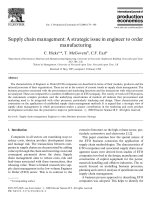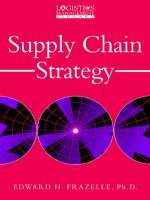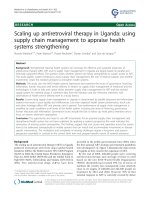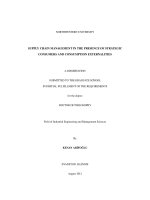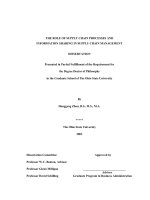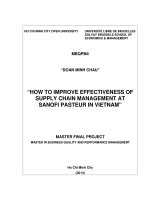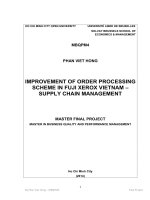The gap in supply chain management at golden sea company
Bạn đang xem bản rút gọn của tài liệu. Xem và tải ngay bản đầy đủ của tài liệu tại đây (941.07 KB, 58 trang )
UNIVERSITY OF ECONOMICS HO CHI MINH CITY
International School of Business
------------------------------
Le Thi Thu Thao
THE GAP IN SUPPLY CHAIN
MANAGEMENT AT GOLDEN SEA
COMPANY
MASTER OF BUSINESS ADMINISTRATION
Ho Chi Minh City – Year 2021
1
UNIVERSITY OF ECONOMICS HO CHI MINH CITY
International School of Business
------------------------------
Le Thi Thu Thao
THE GAP IN SUPPLY CHAIN
MANAGEMENT AT GOLDEN SEA
COMPANY
MASTER OF BUSINESS ADMINISTRATION
SUPERVISOR: DBA. Phan Thi Minh Thu
Ho Chi Minh City – Year 2021
2
Table of contents
Table of Contents
EXECUTIVE SUMMARY ........................................................................................................................ 1
CHAPTER 1: PROBLEM CONTEXT ..................................................................................................... 2
1.1.
COMPANY OVERVIEW .......................................................................................................... 2
1.2.
PROBLEM CONTEXT.............................................................................................................. 5
1.2.1 The gap in supply chain management .......................................................................................... 5
1.2.2 Symptom validation and justification .......................................................................................... 7
CHAPTER 2: PROBLEM IDENTIFICATION ...................................................................................... 9
2.1.
POSSIBLE PROBLEMS.......................................................................................................... 11
2.2.
PROBLEM IDENTIFICATION ............................................................................................. 13
2.2.1 Ineffective Forecasting ............................................................................................................... 13
2.2.2 Financial problem ...................................................................................................................... 14
2.2.3 Ineffective supplier management ............................................................................................... 16
2.2.4 Poor inventory management ...................................................................................................... 18
2.3.
MAIN PROBLEM VALIDATION ......................................................................................... 19
2.3.1 Problem definition...................................................................................................................... 19
2.3.2 Justify the important of main problem ....................................................................................... 23
CHAPTER 3: ALTERNATIVE SOLUTIONS ...................................................................................... 25
3.1 CAUSE VALIDATION .................................................................................................................. 25
3.1.1 No over quotas by level ............................................................................................................. 27
3.1.2 No involvement in formal Win-loss reviews ............................................................................. 28
3.1.3 Inappropriate/ Ineffective winning sales process ....................................................................... 28
3.2 SOLUTIONS ................................................................................................................................... 31
3.2.1 Solution 1: Implement OKRs Model (Objectives and Key results) management in Sales
department........................................................................................................................................... 31
3.2.2 Solution 2: Implement SMART goals model in Sales department ............................................ 33
3.3 SOLUTIONS VALIDATION ........................................................................................................ 34
3.4. ACTION PLAN .............................................................................................................................. 39
3.4.1 Objectives .................................................................................................................................. 39
3.4.2 Timelines and estimated cost ..................................................................................................... 42
CONCLUSION ......................................................................................................................................... 44
REFERENCES .......................................................................................................................................... 45
SUPPORTING INFORMATION............................................................................................................ 48
3
Figures
Figure 1: The company organizational structure .......................................................................................... 4
Figure 2:: PE material data from June 2020 to November 2020................................................................... 6
Figure 3: PP material data from June 2020 to November 2020 .................................................................... 7
Figure 4: The gap between Planning figure and Execution Figure/ Procurement figure in PE material ..... 8
Figure 5: The gap between Planning figure and Execution Figure/ Procurement figure in PP material. .... 9
Figure 6: The Initial cause and effect map .................................................................................................. 12
Figure 7: The Updated Cause and Effect Map ............................................................................................ 22
Figure 8: The relationship between Forecasting and Planning ................................................................... 23
Figure 9: Forecasting the demand in JIT manufacturing systems ............................................................... 24
Figure 10: The second updated cause and effect map................................................................................. 26
Figure 11: The final cause and effect map .................................................................................................. 30
Figure 12: The similarities and differences between OKRs and SMART model ....................................... 36
Figure 13: The advantages and disadvantages of OKRs and SMART model ............................................ 37
Tables
Table 1: Main material data from June 2020 to November 2020 ................................................................. 6
Table 2: Timelines of solution .................................................................................................................... 42
Table 3: Estimated cost of solution ............................................................................................................. 43
Images
Image 1: Key actions being taken by supply chain professionals ............................................................... 16
Image 2: Relationship with key suppliers ................................................................................................... 17
Image 3: Ability to resolve unexpected events with suppliers .................................................................... 17
Image 4: OKRs Model ................................................................................................................................ 32
Image 5: SMART model ............................................................................................................................. 33
4
ACKNOWLEDGEMENT
A completed study would not be done without any assistance and support. Therefore, the
author who conducted this research gratefully gives acknowledgment to the people gave
support and motivation during the time of doing this research as a requirement of
completing my MBA degree.
First of all, I would like to express my thanks and gratefulness to my supervisor DBA. Phan
Thi Minh Thu. Her kindly support and valuable advices went through the process of
completion of my thesis. Her encouragement and comments had a significantly enriched
and improve my work. The thesis cannot be done without her help and her experience in
many fields.
Secondly, I would like to thank Golden Sea company for giving me time to research and
staffs for taking their precious time for interviews. Without the support of the company and
the employees in the company, this thesis would not have been completed.
Thirdly, I would like to express my gratitude to my classmates for sharing, helping and
encouraging each other during this MBA course. And last but not least, I would like to
give my specials thank to my family always beside me and give me encouragement so that
I can finish my thesis.
5
EXECUTIVE SUMMARY
Golden Sea Company is a company with 100% investment capital from Thailand and is
also currently the top company in the production and distribution of rope and net products
in Vietnam today. Golden Sea Company is using 2 main types of plastic materials: PP and
PE plastic. The source of plastic beads produced in the country is currently not enough to
meet the demand, plastic enterprises have to import from abroad.
Especially, the increase in import tax on plastic to 3% from January 1, 2017 also makes the
costs incurred by plastic businesses increase significantly. The import of plastic materials
also makes businesses "worry" about fluctuations in exchange rates in the market. Not only
is the company interested in the price of raw materials, but the quality of raw materials is
also a top priority. The company always choose the leading suppliers of plastic materials,
both domestic and imported in order to ensure the quality of production inputs to help the
Golden Sea brand always be highly appreciated by consumers, creating trust for future
growth. Not only the fluctuation of raw materials in the current market, Golden Sea
Company is also facing supply chain problems within the company. There is a difference
between the forecasting, planning and actuality from the Sales, Planning, Purchasing and
Production departments. Although the company can still manage during the "Coronavirus"
pandemic occurred from the second quarter of 2021.
However, the gap between forecasting, planning and actuality is often much different,
which will have many impacts on production plans, waste operating costs and importantly,
not meet the demand of customer about finished products. Through interviews and research
from theoretical frameworks, the author has discovered the root cause of the problem being
faced at Golden Sea company is that there is no over quotas by level. Finally, the author
proposes a solution with reasonable estimated cost that is to apply the OKRs model to the
Sales department so that each employee can know what their individual goals are, which
is committed by staff level and management levels.
1
CHAPTER 1: PROBLEM CONTEXT
1.1.
COMPANY OVERVIEW
Golden Sea Company was formed with 100% capital investment from Thailand and was
established on 18/7/1995 to be the top manufacturer of Thailand for rope and net used for
fishing, maritime transportation, industrial and agricultural sectors, etc… With 60 years
of accumulated experience in production. Golden Sea' business reputation and product
quality are not only famous domestically but also spread abroad.
With the main vision of bringing the highest technology and the most affordable products
to contribute to the development of the Vietnamese economy, especially in fisheries,
agriculture and some manufacturing industries. With technical products, Golden Sea has
affirmed its strength compared to other manufacturers. Modern technology and production
machinery system with German, Italian, Japanese, Spanish, Indian and Thai technologies
can produce ropes with diameters from 1.5mm - 120mm and capabilities bearing (breaking
force) up to 100 tons. Golden Sea currently has 4 factories: 1 factory at Ho Chi Minh City
and 3 factories at Long An Province with high productivity.
Products with leading quality currently in the Southeast Asian market and recognized
worldwide. (of which the brand currently accounts for 89%, the market share of ropes
accounts for 40% (surveyed by axis) of the rope market for fishing in Vietnam) and is
currently favored by customers around the world such as Matai (Japan), ... And always at
the forefront in the development of technology to produce fishing gears with traditional
rope products as well as Fishery - Instrument materials; Antifouling paint and highpressure lamps are used in fisheries, agriculture and some other applications.
Vision: Making Golden Sea become one of the top suppliers of fishery nets and
fishery products in the Asia.
Mission: Golden Sea always finds the bond between the benefits of our customers,
the community and our company important. Golden Sea believes in offering the
satisfaction for the customers and community by strategic, creative, unique and effective
2
ideas based on advanced technology and local tradition. The result that brought in by
Golden Sea is the added value for the customers, community, company and its employees.
Golden Sea believes in changing the view of the world regarding the image of Vietnam in
the field of fishery nets and tools. Golden Sea believes in creating products with the quality
lasting through the time under the slogan “A steady faith lasting through ups and downs”
Golden Sea believes that developing people is the most important goals of the humanity
civilization. Golden Sea always gathers, develops, encourages and maintains talented
individuals. We provide sufficient work environment, competitive benefit policies and
worthy compensation for their contributions to the success of the company and the benefit
of customer and community. Golden Sea shares the responsibility with the community
“The company chooses the same side with the environment” “the loving bridges”
“warming home”.
3
SHAREHOLDERS
AUDIT
Figure 1: The company organizational structure
Supply chain function includes all logistics management activities including planning and
managing all activities related to sourcing and Procurement, including all logistics
operations. More importantly, it also includes coordination and collaboration with partners
4
in a comprehensive supply chain, which could be suppliers, third-party service providers,
and customers. In essence, supply chain management integrates supply and demand
management within and between different companies. A function that integrates with the
responsibility of linking key business functions and business processes within companies
into a cohesive and high-performance business model. It includes all logistics management
activities noted above, as well as manufacturing activities and promotes the coordination
of processes and activities of the marketing, sales, and design departments products,
finance, information technology.
1.2.
PROBLEM CONTEXT
1.2.1 The gap in supply chain management
During the period of 2020, especially the 6-month period from June 2020 to November
2020, Golden Sea Company has many fluctuations in the supply chain management
situation. Typically, planning figure, procurement figure and execution figure have
differences with each other. Based on the data of some internal reports, it can be seen that
there did not have a synchronization of main materials using plan at Golden Sea company.
Data used for analysis are data for all major material codes related to Polyethylene and
Polypropylene. NPE is an item code for Polyethylene and NPP is an item code for
Polypropylene, 2 main type materials using for production.
Unit: Kg
Source: Internal report
Jun-20
Jul-20
Aug-20
Sep-20
Oct-20
Nov-20
NPE
376,844
291,276
397,816
382,696
502,269
372,526
NPP
342,206
275,774
345,938
380,204
443,717
339,974
Procurement
NPE
372,750
717,750
330,750
108,000
375,000
341250
Figure
NPP
580,000
456,000
241,500
387,750
569250
NPE
329,069
392,341
310,814
307,602
417,710
425,716
NPP
296,871
362,017
272,419
274,316
382,452
383,036
Planning Figure
Execution Figure
5
Table 1: Main material data from June 2020 to November 2020
With the data table presented above, two bar charts will be formed in order to present the
discrepancy of the data in the period from June 2020 to November 2020.
Unit: Kg
Source: Internal report
PE materials
800,000
700,000
600,000
500,000
400,000
300,000
200,000
100,000
2020-Jun
2020-Jul
Planning figure
2020-Aug
2020-Sep
Procurement Figure
2020-Oct
2020-Nov
Execution Figure
Figure 2: PE material data from June 2020 to November 2020
The chart of PE key materials shown over the 6-month period in 2020 shows that
there is no common trait about three-digit trends in planning figures, procurement figures
and execution figures at Golden Sea company. It can be seen that the number of
Procurement has fluctuated up or down markedly. The highest figure was in July 2020 with
more than 700 tons and the lowest figure was in September 2020 with just over 100 tons.
For the other two trends of Planning figure and Execution figure, although there are no
common features of these two trends, the gap between these trends was not too large.
6
Unit: Kg
Source: Internal report
PP materials
700,000
600,000
500,000
400,000
300,000
200,000
100,000
2020-Jun
2020-Jul
Planning figure
2020-Aug
2020-Sep
Procurement Figure
2020-Oct
2020-Nov
Execution Figure
Figure 3: PP material data from June 2020 to November 2020
With the data chart of the main material PP, it can be seen that there is a tendency between
these numbers to be heterogeneous. There are specific months that in July 2020 and
November 2020, the execution figure is much higher than the planning figure. And
although the procurement figures have a huge difference even in August 2020, there is no
transaction activity about this main material. But transaction activities in the remaining
months can ensure that there is no shortage of using for production activities.
1.2.2 Symptom validation and justification
What will happen to businesses when planning figures, procurement figures and execution
figures do not match up? And this symptom can be clearly seen at Golden Sea Company
with the gaps between these number shown below.
7
Unit: Kg
Source: Internal report
The gap of PE material
400,000
300,000
200,000
100,000
0
2020-Jun
2020-Jul
2020-Aug
2020-Sep
2020-Oct
2020-Nov
-100,000
-200,000
-300,000
-400,000
-500,000
Planning vs Execution Figure
Planning vs Procurement Figure
Figure 4: The gap between Planning figure and Execution Figure/ Procurement figure
in PE material
The above bar chart represents that the gap between Planning figure and Execution
figure / Procurement figure in PE materials from June 2020 to November 2020. Positive
figures indicate that the Planning figure is higher than the Execution figure / Procurement
figure. On the contrary, the negative figure can be understood that the Planning figure is
lower than the Execution figure / Procurement figure. In July 2020 and November 2020,
the gap between planning figure and Execution figure in PE material showed negative
fluctuations and this indicates that the supply chain process system goes from planning,
procurement to execution. There is still no synchronization.
And this is no exception for the main material PP, which is more volatile than the PE
material. Positive figures indicate that the Planning figure is also higher than the Execution
figure. But with this chart, the fluctuation between Planning and Procurement figure have
an obvious differences with the number from 200 tons to 300 tons. Besides, the negative
8
figure can also be understood that the Planning figure is lower than the Execution figure /
Procurement figure.
Unit: Kg
Source: Internal report
The gap of PP material
400,000
300,000
200,000
100,000
0
2020-Jun
2020-Jul
2020-Aug
2020-Sep
2020-Oct
2020-Nov
-100,000
-200,000
-300,000
Planning vs Execution Figure
Planning vs Procurement Figure
Figure 5: The gap between Planning figure and Execution Figure/ Procurement figure
in PP material.
CHAPTER 2: PROBLEM IDENTIFICATION
In order to investigate the problems leading to the gap between Planning Figure and
Execution Figure/ Procurement Figure at Golden Sea Company. Some interview was
conducted to figure out some potential problems of this symptom.
The sales department is the department that makes forecasts about the number of sales, so
this is the link between the problems occurring in the supply chain system. And Mrs. Duyen
- Assistant to Deputy Commercial Director is a person who has the ability to give some
discussion about the gap between Planning Figure and Execution Figure/ Procurement
Figure. She mentioned the timing of forecasting as well as how the forecast quantities are
sent to the Supply Planning Department. The Sales Department will forecast the number
of sales each quarter, while the sales department send the plan at the beginning of the month
9
to the Supply Planning Department so that the Supply Planning Department will plan and
notify all relative departments. However, about the change in sales volume, it will depend
on market demand forecasts (sales volume and input materials). In addition, sales volume
also depends on the customer's orders (usually exported sales orders).
The Procurement Department is one of the most important department in the supply
chain system, cause this is the department that directly works with suppliers to meet the
schedule of production plan and generate production according to sales forecast. Besides,
Mr. Quoc Danh is a staff monitoring of the inventory of raw materials and plans to buy raw
materials and some discussion to Mr. Quoc Danh can be mentioned about the gap between
Planning Figure and Execution Figure/ Procurement Figure. According to Mr. Quoc Danh
– Procurement staff in charge of main materials: Due to limited financial capacity, many
contracts are required to change their payment terms. However, some suppliers do not
agree to the change terms, resulting in unsuccessful transactions, and the Procurement
department is forced to look for an alternative supplier. Next, there are many cases where
materials have been negotiated for production plans, but because the storage capacity is
limited and the loading and unloading workers are low, it is not possible to unload and
store these materials. Moreover, the unqualified of input materials is also one of the reasons
leading to the delay in production.
Although the finance department is not part of the supply chain, the procurement
activities are highly dependent on this department. The company currently has the parent
company and branches but according to the policy set out by the Board of Directors, all
raw material purchases will be transacted from the newly established company. According
to Mrs. Phuong Trang – financial executive: Because a newly established company is an
affiliated company, the new company's finances are facing several difficulties. As a new
company, the loan limitation as well as the loan procedures and the ability to manage cash
flow are limited. There are some periods when trading activities are dense and lead to the
company's cash flow exhausting. The Finance Department is required to borrow money
from the bank. Waiting time until the bank disburses also takes a lot of time, so there are
10
some periods when the Finance Department cannot guarantee the payment term of many
purchase orders for input materials
In order to explore more information about the warehouse issue, a small interview
was conducted with Mrs. Hong Thanh - Warehouse Leader. Warehouse department plays
an important part not only in preserving raw materials but also supplying raw materials to
the factory for production. The problem here is, the productivity is increasing, the storage
capacity remains unchanged and the number of employees is decreasing. According to Mrs.
Hong Thanh, the current workforce of the Warehouse Department has been reduced
compared to early 2020. The number of loading and unloading workers in Warehouse 1 is
3 people and Warehouse 2 is 5 people. In addition, the Warehouse department also has to
give priority to export container shipments, so it is difficult to arrange to receive multiple
containers of raw materials - especially those without pallets. Occasionally, in some cases
of transporting goods, the packing of raw materials had trouble. However, this number is
also negligible.
2.1. POSSIBLE PROBLEMS
Based on information from interviews with employees at Golden Sea Company, the initial
cause and effect map is formed as below:
11
Problems
Symptoms
Effect
Unexpected orders
Inapproriate forecasting in sales data
Production planning was delayed
Overdue problem or re-negotiation with
suppliers about payment term
Wasting opex when there is not
enough raw materials for
production
The limited loan procedures for all activites
of the company
The gap between Planning
Firgure and Execution
Figure - Procurement
Figure
Suppliers delivery unqualified materials to
the warehouse
Not enough finished products to
meet the customers need.
Damaged materials left in stock
Not enough storage space and worforce to
manage materials
Figure 6: The Initial cause and effect map
12
Consequences that business has with the problems outlined above are: delayed production
planning, wasted operating expenses when there is not enough raw materials for production
and finally not enough finished products to meet customer needs. These are serious
consequences that Golden Sea business has to face with if the symptoms last long. And it
can be seen that no manufacturing enterprise can avoid serious consequences if the
enterprise does not consider the causes to come up with appropriate solutions.
2.2. PROBLEM IDENTIFICATION
From the above initial cause and effect map, there are seven potential problems identified
from the interviews that are:
o Unexpected orders
o Inappropriate forecasting in sales data
o Overdue problem or re-negotiation with suppliers about payment terms
o The limited loan procedures for all activities of the company
o Suppliers delivery unqualified materials to the warehouse
o Damaged materials left in stock
o Not enough storage space and workforce to manage materials.
Thus, deeper analysis of the interview results and literature theories are supporting to figure
out the main problem leading to the gap between Planning figure and Procurement figure/
Execution figure at Golden Sea Company.
2.2.1 Ineffective Forecasting
According to Hendricks & Singhal (3), the phenomenon supply chain glitches is explained
as mismatches between supply and demand, which have shown to affect to company’s
short and long-term profitability. And one of the primary reason lead to supply chain
glitches is the inaccurate forecasting. And Fisher & Raman (3) also stated that “the perfect
forecast is usually impossible although demand forecast are important. Cause the demand
is affected by a variety of factors and the level of uncertainty is large.”
13
As the study of Oliva and Watson mentioned about two potential sources of forecast bias
are intentional and unintentional, that lead to huge effect to forecasting performance. About
intentional biases, which were driven by incentive misalignment and differences in the
disposition of power. On the other hand, unintentional biases were driven by cognitive
limitations. Different departments are evaluated according to separate criteria, performance
and are rewarded on the completion of those activities. Thus, forecasts might be biased in
such a way to benefit one’s own agenda.
Forecasting is critical for the business and for all governance decisions. Forecasting is also
fundamental to planning and control. In the production planning, finance and accounting
functions, forecast figures are the basis for cost control and budgeting. The manufacturing
and operations department uses forecasting data to make periodic decisions about supplier
selection, process selection, capacity planning, facility layout, decision making and
continuous on purchasing, production planning, scheduling and inventory control.
Regarding this problem Mrs. Tuong Lan gave the opinion that: “Each month the Planning
Department will receive a forecast of sales volume from the Sales Department. The Planning
Department will then calculate the quantity of materials for production and send an email at the
beginning of the week detailing the quantity of these materials to relevant departments to capture,
eg: Sales Department, Purchasing Department, Department Warehouse, Factory…
When there is a change in Production / Production output from the Sales Department, the Planning
Department recalculates the quantity of raw materials to promptly notify the relevant departments.
However, there are some instances where productivity changes from management direction (as
market volatility will increase or decrease).”
2.2.2 Financial problem
According to Trevor Miles
(6)
– one of the commentators and the consequences from the
SCM World Chief Supply chain officer report survey 2010 clearly indicated the importance
and benefits of closing the gap between Planning figure and Procurement Figure/
Execution Figure. The business driving factors behind this demand starts from customer
expectations of reduced order-to-delivery lead times and the competitive pressure to launch
new products to market in shorter and shorter cycles. However, the gap is even wider than
14
just between supply chain planning and execution. And this is caused from the gap between
financial planning and supply chain planning. And this can be considered that financial
problem – payment procedures problem in particular is also one of the problems causing
the current symptoms of Golden Sea Company.
Min and Zhou 2002
(1)
mentioned about finances issue in supply chain that “A
supply chain network transfers information, products and finances between different
suppliers, manufacturers, distributors, retailers and customers. The supply chain is
characterized by a forward flow of goods and a reverse flow of information. Typically, a
supply chain consists of two main business processes: materials management and physical
distribution.
Different entities in a supply chain often operate autonomously with different goals
and constraints. However, when it comes to improving critical performance, increasing
quality, or reducing costs, they become very much interdependent. It is the flow of material,
resources, information, and finance that provide the force of engagement.
Source: SCM World Chief Supply Chain Officer Report Survey 2010
15
Image 1: Key actions being taken by supply chain professionals
With the image 1 “Key actions being taken by supply chain professionals, it can be seen
that financial arrangements with customers or suppliers is one of the most important
activities occurring at company. And that proves that financial problems - specifically
about payment procedures have a big impact on the symptom “The gap between Planning
figure and Execution figure/ Procurement figure.
Mrs. Phuong Trang – financial executive shared that: “As a new company, the loan limit as well as
the loan procedures and the ability to manage cash flow are limited. Many L / C payment procedures
for foreign payments are also difficult - the allowable limit is low and the payment value of the
contract is high.
There are some periods when trading activities are dense and lead to the company's cash flow
exhausting. The Financial Department is required to borrow money from the bank. The time to wait
until the bank disburses also takes a lot of time, so there are times when the Financial Department
cannot guarantee that the payment term of many purchase orders for input materials.”
2.2.3 Ineffective supplier management
The research was conducted by Peerless Research Group (PRG) (7) on behalf of Supply
Chain Management Review and Logistics Management for E2open indicated that “In
general, many interviewed believe that the working relationship with suppliers is very
reliable and that they are a perfect match for their partners or keep in regular contact when
dealing with any issues in supplying outsource materials at company. However, one-third
(33 percent) disclosed that they were dissatisfied with their suppliers, said that some
partners may not be proactive or react promptly when necessary, or that they simply fall
short in full-filling requests”.
16
Source: Peerless Research Group
Image 2: Relationship with key suppliers
The research stated that “Many of our key suppliers are neither responsive nor timely. Due
to the uniqueness of our product line, holding suppliers accountable is challenging!”
Sourcing & Procurement; Healthcare; $1B-$9.9B
Source: Peerless Research Group
Image 3: Ability to resolve unexpected events with suppliers
17
The above theories partly explain the problem of supplier management of businesses today.
Not only Golden Sea Company but also many other businesses are facing this same
problem.
With the sharing from Mr. Quoc Danh - Purchasing executive: “The inspection of input materials
is also quite rigid, leading to many times when the materials are already in stock but have not been
used yet because the QA department has not yet released the test results.
Occasionally, Supplier deliveries of poor quality. Sometimes, the order is urgently needed for
production, but when the supplier arrives, it does not meet the quality.”
2.2.4 Poor inventory management
According to William Brandel (2): “In today's difficult and volatile business environment,
distribution-intensive companies such as retailers and distributors have to match supply
with demand - not only to a competitive advantage but also to survive. Achieving that goal
requires operational approaches (such as implementing buffer inventory) that might
sometimes contradict the tradition of inventory management: cost control and efficiency.
This finding (2) is also concerned about shift in strategy means that cost reduction, the key
marker of inventory efficiency, now runs a distant second to improving service levels. This
does not mean that companies are adopting a demand-driven strategy that ignores cost.
However, the road to demand-driven inventory management will put a great deal of
pressure on companies' ability to control costs.
18
Source: SCM World Chief Supply Chain Officer Report Survey 2010
Image 1: Key actions being taken by supply chain professionals
With the research by SCM World chief supply chain officer 2010, key action about laid off
people from the supply chain organization took the fourth place, with 33 percent responded
by C-level and 31 percent by others.
And this case is also the same with the mention of Mrs. Hong Thanh - Warehouse leader: “Because
in 2020, the workforce of warehouse was cut compared to the previous times. Although production
capacity of the company is higher, but due to the cut cost policy, warehouse workforce was also cut
following by the requirement from Board of Director.”
2.3. MAIN PROBLEM VALIDATION
2.3.1 Problem definition
According to the definition about Forecasting of Cambridge
(5)
, forecasting is the job or
activity of judging what is likely to happen in the future, based on the information have
now. In order to have a better understanding about this definition, another explanation from
Corporate finance Institute
(4)
will be more specific in the economic sector. “Forecasting
19
refers to the practice of predicting what will happen in the future by taking into
consideration events in the past and present. Basically, it is a decision-making tool that
helps businesses cope with the impact of the future’s uncertainty by examining historical
data and trends. It is a planning tool that enables businesses to chart their next moves and
create budgets that will hopefully cover whatever uncertainties may occur”
Anwar (8) stated that “Forecasting is one of the oldest management activities. The choice
of forecasting method must start by a clear statement of the purpose for which the forecast
is being made. Forecasting is also an effective part of inventory management. Furthermore,
forecasting is the prediction or estimation of the occurrences of uncertain future events.
Besides, forecasting offers an organization some foresight in the premeditation of
appropriate courses of action.
Organizations typically rely on two types of forecasts, concrete judgments and statistics.
The best forecasts are often made from a combination of these methods. Some companies
still un-necessarily rely on predictive forecasts. Makridakis et al.
(9)
stated that any
alternative involving predictive forecasting is bound to fail because the amount of effort
and the monotony of the work involved preclude the possibility that any individual who
does the job without feeling bored and unproductive. Predictive judgment is greatly
influenced by fantasies and special considerations. Furthermore, judgmental bias is
common in forecasting. This finding was found by Hogarth and Makridakis
and Adams
(11)
and Schnaars
(12)
(10)
; Moriarty
. Judgmental forecasts can lead to large and systematic
errors due to bias in the way information about the future is processed.
With the analysis of each potential problems, the author can see that the Forecasting can
cover all given problem, for example: Sales forecasting, demand forecasting, financial
forecasting…. In conclusion, following some interviews were conducted with Golden Sea
company staff and literature reviews, there are four central problems which include
ineffective forecasting, financial problem, ineffective supplier management and the last is
20
